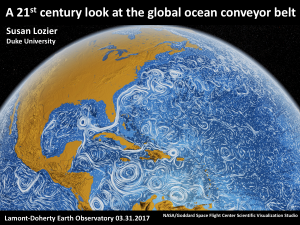
The Coastal Institute hosted the 5th Annual Scott W. Nixon Lecture featuring Dr. Susan Lozier of Duke University on April 13, 2017. Dr. Nixon had a lifelong commitment to big-picture thinking and to challenging seemingly-accepted scientific theories, a commitment that Dr. Lozier shares as she challenges traditional thinking about how our ocean waters circulate the globe and how climate change is impacting these circulation patterns.
The first paradigm Dr. Lozier upended: the “conveyor belt” ocean circulation map that you likely learned in high school or college is wrong. While it was cutting-edge when it was developed in the 1800s and remains a remarkable work of scientific observation for that time, advancements in oceanography over the last several decades shed new light on this oversimplified model. Instead of a smooth conveyor belt of water movement, our oceans are full of small eddies that retain some waters locally while exporting other waters more broadly. Exactly how much water, especially deep ocean waters, is being exported is a critical question that Dr. Lozier is investigating.
How does this paradigm shift impact the big-picture thinking on ocean circulation? Dr. Lozier’s ocean transport models and her observations from aboard oceanographic ships, particularly in the Labrador Sea, do not match climate model predictions. Major climate models are predicting that ocean circulation could slow by as much as 30% as sea surface temperatures increase, but Dr. Lozier does not see evidence that supports the prediction. Instead of completely discounting climate models, she is collaborating with climate modelers to determine how to improve their models to better predict the future impacts of climate change.
Dr. Lozier views the increased understanding of sea surface temperatures and the subsequent fine-tuning of climate models to be the next big break-through in oceanography: when our models catch up to our observations, we can better predict long-term climate change that accurately incorporates natural forcing and anthropogenic influences.
Watch Dr. Lozier’s full presentation below:
